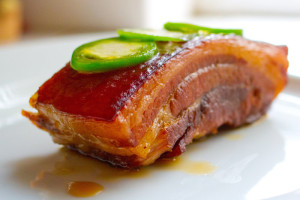By: Kelsey Tenney

(source: www.theconversation.com)
Sweet, salty, sour, bitter, umami. The five basic tastes. The subject of taste, however, has plagued scientists, philosophers, and epicureans for centuries. In fact, up until 2002 umami was not an accepted taste. There is currently a debate over a sixth primary taste. Should fat join the ranks of sweet, sour, bitter, salty, and umami?
Historically, taste was defined as a philosophical question. The Chinese generally counted sweet, salty, sour and bitter among their repertoire but added pungent into the mix. They related the tastes that they defined to the elements of Chinese philosophy: earth, metal, water, fire, and wood. The Western philosophers took a crack at taste as well, but they regarded taste as the gluttonous sense. While sight and hearing allowed us to develop and understand language and art, taste promoted self-indulgent behavior. Nevertheless, ancient Greek philosophers tried their hand at it. Plato perceived six tastes—bitter, sweet, salty, sour, astringent, and pungent. Aristotle made the matter much more complex by mapping taste between two poles. He asserted that sweet and bitter were on opposite ends of the spectrum with salty, pungent, harsh, astringent, and acidic somewhere in between. Finally, Theophrastus, who studied under both of the philosophers added oily to the mix making eight basic tastes.
This list was generally accepted as fact until the eighteenth century. The enlightenment was in full force in Europe, and scientists were challenging many common beliefs. Interestingly enough, taste became incredibly difficult to define. Carl Linnaeus named eleven basic tastes (bitter, fatty, sour, astringent, sweet, salty, sharp, viscous, insipid, aqueous, and nauseous) while Père Polycarpe Poncelet equated taste to harmonizing music notes naming seven notes (bitter, acid, sweet, peppery, astringent, sweet and sour, and weak or tasteless). Brillat-Savarin, on the other hand, was a renowned French epicure and believed that taste was infinite. He alleged that “the number of tastes is infinite, since every soluble body has a special flavor, which does not wholly resemble any other.”
The nineteenth century cemented our four tastes. Simplicity was ideal, and Adolf Fick, a German doctor, narrowed the tastes down to sweet, salty, bitter, and sour. In addition, taste buds were discovered when tongue cells were examined under a microscope. Taste buds looked like keyholes that bits of food might fit into. It was generally believed that there were four different keyhole shapes agreeing with Dr. Fick’s assertion.
Umami came onto the scene in the twentieth century challenging the status quo after French superstar chef Escoffier created veal stock and Dr. Ikeda decided that a savory flavor in his dashi could not be explained by the four tastes. Umami is now in the textbooks as the fifth taste. It only took 100 years.
What exactly constitutes a taste? There are five criteria: 1) There must be a class of stimuli responsible for the perception, 2) There must be mechanisms present that change the chemical code of the stimuli to an electric signal, 3) That electrical signal must be neurotransmitted to the brain, 4) The stimuli must be completely independent from other tastes, and 5) The stimulus must generate effects in the body downstream from the mouth.
Sweet is triggered by sugar telling us we are eating carbohydrate, sour is activated through hydrogen ions reflecting excessive acid, amino acids (predominantly glutamate) set off umami, salty is elicited by sodium and potassium ions indicating the presence of minerals, and many molecules meant to trigger toxin signals are perceived as bitter.

(source: www.npr.org)
But what about fat? Recent arguments have been made by Dr. Russell Keast toward such.
Criteria 1: The breakdown products from fats and free fatty acids are considered the stimuli for fat perception. Lingual lipase break down triacylglycerols, the predominant form of fat in food, so that the fatty acids and other breakdown products can be perceived.
Criteria 2: Recent research points toward two potential receptors responsible for transduction of the signal—CD36, a fatty acid transporter, and G protein-coupled receptor 120, a fatty acid receptor that activates a peripheral signaling cascade.
Criteria 3: The neurotransmitter carrying the fat signal to the processing region of the brain requires more research, but there is some indication that noradrenaline and serotonin are secreted in response to fatty acids triggering the orosensory perception.
Criteria 4: Perceptual independence of fat is proven through detection thresholds of fatty acids completely separate from other basic tastes. Fat taste quality, however, is different than other tastes. When you taste sugar, you automatically identify sweet. Fat is detected at a low level, but the recognition of that taste as fat is not apparent until supra-threshold is reached. At that point, other chemosensory systems are likely involved.
Criteria 5: A 2.8-fold increase in plasma triacylglycerol concentration has been recorded in humans following oral fat consumption. Additionally, fatty acids have been shown to activate signaling chains in the body that prepare it for fat digestion and absorption.
Fat meets the criteria of what a taste is, but it doesn’t act like any of the others. According to fat researcher Dr. Richard Mattes from a recent NPR interview, if fat were to become a primary taste, it would change “our basic understanding of what taste is.” A change in the taste repertoire could be extremely helpful for future product development. As we commonly associate fat being important to the texture and flavor profile of foods, fat replacements in low-fat foods are meant to mimic those characteristics. If we can actually perceive the taste of fat, that would explain why low-fat products just aren’t making the cut.
Dr. Russell Keast has also drawn a correlation between individuals with high BMIs and lower sensitivity to the taste of fat. In other words, more fat is required to get the same sensation. Individuals that are less sensitive to the taste of fat are likely to overconsume fatty foods. Increased understanding of fat as a taste could shed light on this pattern
What do you think? Should fat become the sixth taste? Only time and more research will tell.
Want to keep up with the conversation? Follow us on Instagram and Facebook for quick updates on seminars, events, and food science!
 About Kelsey: I grew up in Minnesota constantly in awe of innovative companies like General Mills and Cargill. After touring Cargill kitchens in high school, I decided food science was my niche. I received my Bachelor’s from Purdue University and continued on to The Pennsylvania State University where I am working on a Master’s concentrating in food chemistry. In my free time I love to bake and cook in order to experience food science in all its glory. I recently started the blog www.appeasingafoodgeek.comdetailing my culinary adventures. When I’m not in the lab you can usually find me multitasking between testing a cookie recipe, watching an old episode of X Files, and trying to find my wine glass.
About Kelsey: I grew up in Minnesota constantly in awe of innovative companies like General Mills and Cargill. After touring Cargill kitchens in high school, I decided food science was my niche. I received my Bachelor’s from Purdue University and continued on to The Pennsylvania State University where I am working on a Master’s concentrating in food chemistry. In my free time I love to bake and cook in order to experience food science in all its glory. I recently started the blog www.appeasingafoodgeek.comdetailing my culinary adventures. When I’m not in the lab you can usually find me multitasking between testing a cookie recipe, watching an old episode of X Files, and trying to find my wine glass.
References:
Keast RSJ, Costanzo A: Is fat the sixth taste primary? Evidence and implications. Flavour 2015, 4:5.
Keast RSJ: Tasty treat: how we showed fat to be the sixth taste. The Conversation 2015.
Singh M: Salty, sweet, sour. Is it time to make fat the sixth taste? NPR 2015.
Krulwich, R: Sweet, sour, salty, bitter…and umami. NPR 2007.
Aristotle: De Anima. 350 BC.
Chale-Rush A, Burgess JR, Mattes RD: Evidence or human orosensory (taste?) sensitivity to free fatty acids. Chem Senses 2007, 32(5): 423-431.
Galindo MM, Voigt N, Stein J, van Lengerich J, Raguse JD, Hofmann T, Meyerhof W, Behrens M: G protein-coupled receptors in human fat taste perception. Chem Senses 2012, 37(2): 123-139.
Abumrad N: CD36 may determine our desire for dietary fats. J Clin Invest 2005, 115(11): 2955-2967.
Keast R, Roper J: A complex relationship among chemical concentration, detection threshold, and suprathreshold intensity of bitter compounds. Chem Senses 2007, 32(3): 245-253.
Mattes RD: Fat taste and lipid metabolism in humans. Physiol Behav 2005, 86(5): 691-697.
Cover image: www.newston.net






Good review! A side question: what is the taste of blood? Salty?
Good question!
Blood could be metallic which is the possible seventh taste, but more research still needs to be done.
Kelsey,
Thanks for the neat article! Could you provide a little insight into Dr. Mattes’ comment that defining fat as a taste would change “our basic understanding of what taste is.”? What does he mean by that? Why could setting fat as a taste be so, novel/different/game changing?
Suzy,
Thanks for the comment! Dr. Mattes’ basically means that if fat were to be named the sixth taste, it would be completely different from the other five because we cannot provide a description for what fat tastes like. Experiments done in the area have shown that panelists can tell that something is different in the presence or absence of fat, but they don’t know what it is. All of the other tastes have descriptors that are readily available.
Hi Kelsey when you say that fats taste could not be described could we not assume that fat tastes oily or greasy?
Yes, you would assume that we are great at identifying fatty tastes as oily or greasy, but in practice, Dr. Keast and his team found that almost none of the participants could identify the fatty acids/oils. They could tell something was there, but they couldn’t put their finger on it. I’m guessing that part of this was the level of fat used. Keast wrote a follow-up to his article here (https://theconversation.com/tasty-treat-how-we-showed-fat-to-be-the-sixth-taste-37522) if you want to see how he explains it!
Hi Kelsey,
This article is very interesting I have never once even considered fat to be a taste. If it does become a taste how would average people like myself describe it? Would we call butter fat tasting?
If it was found that people who tend to overeat fatty substances are less sensitive to the sensation would this perhaps open up new areas in solving eating disorders by somehow increasing sensitivity? 15229272
Anouk,
Thanks for the comment! One of the controversies surrounding fat as a taste is that work done in the area has shown that we don’t know how to describe fat. When you give people samples with and without fat, they know that something has changed, but they don’t know what. One of the only exceptions is when there is a large amount of fat or oil, we call that oily or greasy. So I guess we don’t know yet how you would describe it! And for the sensitivity, that could perhaps be a solution to solve eating disorders. It is still unclear, however, if those sensitivity levels were always present and caused the difference in weight levels, or if over-exposure to fat eventually caused a decreased sensitivity to fat and vice versa. For example, in general, type II diabetes is often associated with an over-exposure to glucose decreasing the effectiveness of insulin. But it is a very interesting area of research!
Hi Kelsey,
Thank you for such an interesting article which prompted me to read up more on the subject of fat being classified as the sixth taste.
From what I have learned from different sources, it can be seen that the evidence is comprehensive to confirm that fat is the sixth taste. An idea to confirm this notion stems from the concept of low-fat products. One cannot remove the fat from foods and replace the textural aspects and flavour release because the taste element cannot be replicated. Would you agree this is the reason why consumers often feel that these products simply ‘don’t cut it’ in comparison to full fat options?
It can also be noted that this taste has a relationship with diet and bodily well-being that the other five tastes do not. Studies conducted by the School of Medicine at Washington University in St Luis revealed that people with an increased number of a sensory receptor (CD36) were able to detect the presence of fat in food better than other individuals. In support for the confirmation of the fat taste, do you agree with the idea of differences in taste sensitivity to fat associated with varying consumption levels of fat in an individual’s diet? Therefore, for fat to be considered the sixth taste, is this confirmed when every individual can identify a certain level/amount in the food source and know that the taste is fat-based? 15037755
Erin,
Excellent comment! I completely agree with your points. Low-fat foods usually don’t cut it because they can’t replace the textural/flavor properties. Developers have been trying to figure out why for quite a while, and this research will perhaps shed light on solutions they have not considered. As for the taste sensitivity, that’s exactly what I understand it as. Differing sensitivities can be correlated to diet. The final point is correct as well. Individuals can generally identify differing levels of fat. And that reflects back on sensitivity to fat. Thank you for the comment and extra research! I think you and I can both agree on fat being the sixth taste.
Could it be said that the body tastes sensors are more attracted to fat/fatty tastes more so than others resulting in ‘at being the sixth taste?
That is an interesting thought, but I don’t think the research has addressed the “strength” of attractiveness via fat versus other stimuli. It would make for a great argument potentially. Thanks for the comment!
In regards to this theory, would saturated and unsaturated fats be classed together under the same taste? After all I cannot imagine adding a drop of sunflower oil to my coffee in the place of milk or cream. Nor can one liken the delicious flavour of crispy bacon fat to that of any plant derived oil.
I think that is a little more nuanced. The fat taste is likely to be a large umbrella that has different types housed underneath it. For example, turnips and grapefruit are both classified as bitter, but they are definitely not interchangeable. The taste of olive oil and soybean oil are drastically different, but I would classify both as having the predominant taste of fatty. All lipids and fatty acids that trigger the sensations associated with the classifications listed above would be considered as tasting of fat. The other ingredients in products such as the proteins, sugars, and water in something like cream adds to the overall flavor profile. I think fat as a taste will likely add to the complexity of how we think we perceive foods. I don’t think it will act as a reason to replace some fats with others. Thanks for the comment! Good food for thought.
if you want to classifier fat as the sixth taste then what does it taste like , does fat not taste like salt .And what types of fats would be classified as fats like trans-fats mono-saturated unsaturated fats would they all be classified as having the same taste ? if not then fat cant be classified as the sixth taste as there is not one taste of fat.
Great point! Like I mentioned above, we cannot put our finger on what fat tastes like. It could be recognized generally as a taste because it fits all of the criteria of what defines a taste, but it cannot be given a descriptor. That’s why this idea is so radical to the five other tastes. I think currently, any lipid or fatty acid that has the general n-carbon chain is being classified into the fat taste category. In the research from the last few years, they used several different fat types to broadly show that the hypothesis was universal to all fats.
Is it possible that the reason taste doesn’t have definite senses, is that others taste buds are more sensitive compared to others? I’d just like to understand what the different tastes are tested against. I understand that there is a criteria that is followed, does that mean there is no actual person doing the tasting, and if so, my taste bud question still stands.
Is it possible that the reason taste doesn’t have definite senses, is that others taste buds are more sensitive compared to others? I’d just like to understand what the different tastes are tested against. I understand that there is a criteria that is followed, does that mean there is no actual person doing the tasting, and if so, my taste bud question still stands.
u14036968
Amo,
I’m not sure that I understand your question. Are you asking whether the taste receptors for sweet/salty/bitter/umami/sour are more sensitive than the potential receptors for fat? And that this means that fat should not be classified as a taste? I don’t think sensitivity is a protocol for taste. For example, the sensitivity for bitter is extremely higher than the sensitivity for sugar. They use human panelists for the tests, so they have data from people tasting the samples. Let me know if that answers your question?
A very interesting article! I would just like to know, I read around that the first four main tastes have certain quadrants on the tongue where taste buds would receive the certain taste and transfer this message to the brain. If so, where would umami and fat fall in?
Hi Kelsy! Thanks for the comment. Are you referring to the tongue map? This hypothesis has been largely proven false. The idea does still persist though, so it’s understandable that you have this question. The tastes use different taste receptor cells, but all of the areas on your tongue are sensitive to all of the tastes.
So it is not true or fair to say that you taste the four main tastes in different parts of the tongue?
That is correct. The tongue map has been debunked and was actually popularized because of a mistranslation of an academic paper. It’s taking a while for the map to go away, however. So don’t be fooled by those out of date textbooks!
Hi Kelsey
Thanks for such a great article, it was a very interesting read and inspired me to research the topic of fat as a 6th taste in a bit more detail. Would it be possible for you to expand a bit more on the correlation drawn up by Dr. Russell Keast? How did he go about finding the results that he did? Also, you mentioned that if fat was indeed classified as a 6th taste “A change in the taste repertoire could be extremely helpful for future product development”, what kind of developments could we expect?
Thank you for the comment! I was thinking of doing a second article specifically on the correlation that Dr. Keast made between the sensitivity to fat and obesity. He is in the process of conducting new research, and the article was getting a little long, so I just mentioned it as a blurb. His papers do have some preliminary data as well as his articles on The Conversation as listed above in the references. Feel free to check it out in the meantime while I wait for more data from his lab group. As for the product development comment, I was alluding to the fact that currently fat is only thought of as important to flavor carrying and texture. Most low-fat products simply bump up the flavor profiles and add texture replacers (such as gums) to replace that missing fat. If fat is recognized as a taste itself, more research would need to be conducted for replacing that taste in addition to the texture and flavor. This could be the reason for the ineffectiveness of low fat products. I’m sure we wouldn’t be able to harness this information right away in product development, but it could mean a future of better reduced fat foods!
Thank you Kelsey for a very interesting article.
I have never thought about this before which prompted me to read further into the matter of fat being a sixth taste.
Dr. Russell Keast made correlations in your article between individuals with high BMIs and lower sensitivity to the taste of fat. So it could be concluded that people who over consume fatty foods will be less sensitive to the taste of fat. Could this not stir a discussion on solving eating disorders such as obesity by increasing a persons sensitivity towards fat?
According to Tamara Cohen for the Daily mail scientists now believe that there is a genetic variant that can make some people more sensitive to fat molecules than others. Scientists always assumed that people were attracted to fatty foods because of its smell and texture but they are starting to feel differently. Washington University School of Medicine researchers found that obese people’s cravings for fatty food may be related to their levels of a receptor called CD36. The study found that people who are less sensitive to the presence of fat in foods could be driven to eat more of it.
It is important for people to detect fat in foods in order for one to maintain a healthy and balanced lifestyle. This is why i believe fat should be considered a sixth taste because if people were more sensitive towards it, it could start to lower the about of eating disorders such as obesity we see now days .
Thank you
Jessica McLean u15012990
Thank you for the comment Jessica!
That would be an interesting solution to eating disorders. I don’t think enough research has been done yet for this application, but it should definitely be looked into. It seems like it could be extremely effective. Your point about how fat should be classified as a taste because of the sensitivity argument is a great point! If for nothing else, it seems like proof enough to me too!
A very interesting article.
I understand that there are 5 criteria when referring to taste but with our population growing and a greater demand for food could we not say that the taste of fat might be disguised by flavorants and preservatives that are added into food now days. Would saturated and unsaturated fats be classified as the same thing?
Thank you Linda! This work did not investigate the effect that additional ingredients have on the taste of fat and its perception, but I could see your point. I think the overall idea is that even with additional flavors, the basic tastes can still be perceived (like sweet or sour). And I think both saturated and unsaturated fats would both be classified as having the taste of fat. Just like the other tastes, there are subtle differences in the flavor profile, but they all have the basic taste of fat. There is definitely more to come on this topic, however!
Look up oleogustus, fat is now the 7th taste, after kokumi.
Conference Series LLC Ltd is delighted to cordially invite all the interested participants across the globe to “22nd Euro-Global Summit on Food and Beverages“to be held during February 28-March 02, 2019 at London, UK.
We organise “22nd Euro Global Summit on Food & Beverages” (Euro Food-2019) at London, UK from February 28 to March 2, 2019 that is focused around the theme “Next Gen of Food Innovation”. The conference provides a lucrative platform and opportunity to meet experts around the globe. We have multifarious platform available: Speaker /Delegate/Exhibitor/media Partner/Workshops/Symposiums /Poster/E-poster/Video Presentation etc. Kindly let us know your interest so that we can let you know the further procedure.